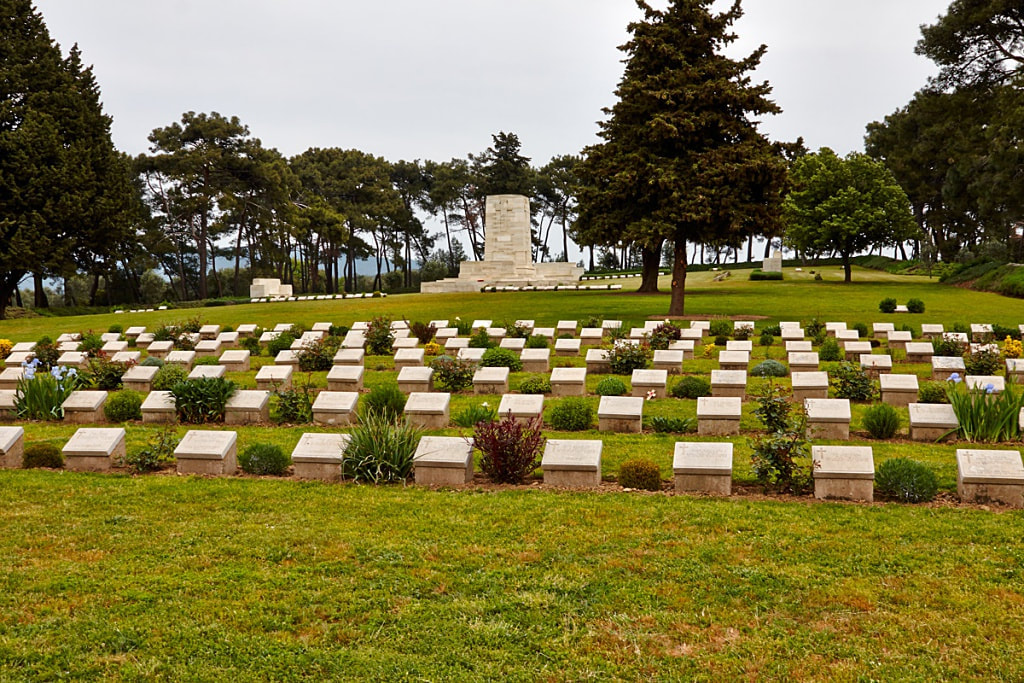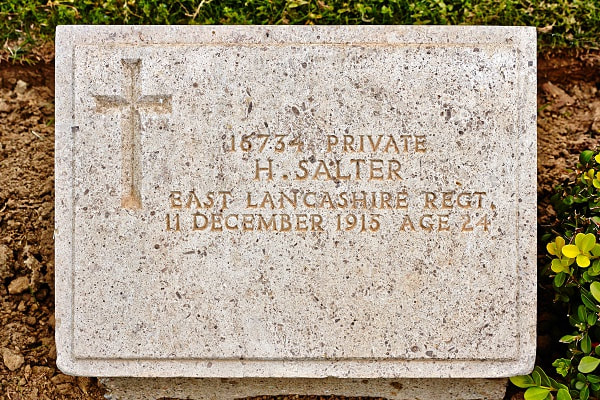GREEN HILL CEMETERY (SUVLA)
Gallipoli
Turkey
GPS Coordinates Latitude: 40.29303 Longitude: 26.27983
Location Information
Heading North from Anzac, you will encounter Green Hill cemetery after 17.6 kms. on the right, adjacent to the track.
Green Hill and Chocolate Hill (which form together Yilghin Burnu) are adjoining areas of raised ground (approx 52 metres above sea level), which rise almost from the eastern shore of the Salt Lake. The cemetery lies on the east side of the Anzac-Suvla Road.
Visiting Information
The Cemetery is permanently open and may be visited at any time.
Historical Information
The eight month campaign in Gallipoli was fought by Commonwealth and French forces in an attempt to force Turkey out of the war, to relieve the deadlock of the Western Front in France and Belgium, and to open a supply route to Russia through the Dardanelles and the Black Sea.
The Allies landed on the peninsula on 25-26 April 1915; the 29th Division at Cape Helles in the south and the Australian and New Zealand Corps north of Gaba Tepe on the west coast, an area soon known as Anzac. On 6 August, further troops were put ashore at Suvla, just north of Anzac, and the climax of the campaign came in early August when simultaneous assaults were launched on all three fronts.
The aim of the Suvla force had been to quickly secure the sparsely held high ground surrounding the bay and salt lake, but confused landings and indecision caused fatal delays allowing the Turks to reinforce and only a few of the objectives were taken with difficulty.
Green Hill and Chocolate Hill (which form together Yilghin Burnu), rise from the eastern shore of the salt lake. They were captured on 7 August 1915 by the 6th Lincolns and the 6th Border Regiment but once taken, no further advance was then made. On the two following days, unsuccessful efforts were made to push on along the ridge of 'W' Hill (Ismail Oglu Tepe), leading to Anafarta Sagir and on 21 August, the attack of the 11th and 29th Divisions and the 2nd South Midland Mounted Brigade to take Scimitar Hill, although pressed with great resolution, left the front line where it had been.
Green Hill Cemetery was made after the Armistice when isolated graves were brought in from the battlefields of August 1915 and from small burial grounds in the surrounding area. These earlier burial grounds were known as York; 40th Brigade Nos. 1 and 2; Green Hill Nos. 1 and 2; Chocolate Hill; Inniskilling; Salt Lake; and Scimitar Hill (which contained 520 graves, almost all unidentified).
There are now 3,089 servicemen of the First World War buried or commemorated in this cemetery. 2,587 of the burials are unidentified but special memorials commemorate a number of casualties known or believed to be buried among them.
Total Burials: 3,089.
Identified Casualties: United Kingdom 501, India 1. Total 502.
Unidentified Casualties: 2,587. Total 2,587.
Cemetery pictures © Geerhard Joos
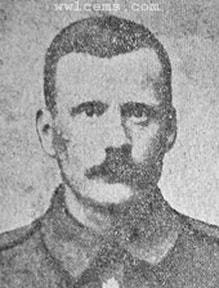
11883 Private
Edward Butler
6th East Lancashire Regiment
Killed in Action 11th December 1915, aged 30.
Plot I. G. 18.
Lived at 6 Fell Street (off Finsley Gate), Burnley, Lancashire.
Edward Butler
6th East Lancashire Regiment
Killed in Action 11th December 1915, aged 30.
Plot I. G. 18.
Lived at 6 Fell Street (off Finsley Gate), Burnley, Lancashire.
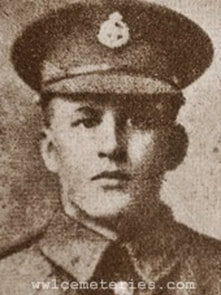
20767 Private
Herbert Crossley
6th East Lancashire Regiment
Killed in Action 11th November 1915, aged 20.
Plot II. G. 20.
Son of Luke and Emily Crossley, of 77, Beaufort St., Nelson.
Herbert Crossley
6th East Lancashire Regiment
Killed in Action 11th November 1915, aged 20.
Plot II. G. 20.
Son of Luke and Emily Crossley, of 77, Beaufort St., Nelson.

11630 Lance/Corporal
John Dacey
6th East Lancashire Regiment
Killed in Action 10th November 1915, aged 38.
Plot I. A. 9.
Son of Patrick and Mary Dacey, of Burnley; husband of Catharine Dacey, of 6, Parker St., Burnley.
John Dacey
6th East Lancashire Regiment
Killed in Action 10th November 1915, aged 38.
Plot I. A. 9.
Son of Patrick and Mary Dacey, of Burnley; husband of Catharine Dacey, of 6, Parker St., Burnley.
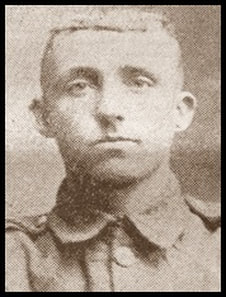
12203 Private
James Fielding
6th East Lancashire Regiment
Killed in Action 12th December 1915.
Plot I. G. 23.
Lived at 23 Byron Street, Burnley, Lancashire.
James Fielding
6th East Lancashire Regiment
Killed in Action 12th December 1915.
Plot I. G. 23.
Lived at 23 Byron Street, Burnley, Lancashire.
Shot at Dawn
16734 Private Harry Salter, 6th Bn. East Lancashire Regiment, executed for desertion 11th December 1915, aged 24. Plot 1. G. 26. Son of the late Daniel and Charlotte Salter, of Bridgwater, Somerset.
On 1 Nov 1915, he absented himself from his battalion, being next seen on 11 Nov when he was brought, still in uniform, to a Sergeant Major of another regiment, who on 16 Nov handed him over to an escort from his own regiment.
En route to his battalion, Salter escaped while his escort was sleeping. Arrested again on 18 Nov, Salter escaped again, but was found the next day, wearing an Australian uniform.
At trial, he made no attempt to defend himself on the charges of desertion & escaping. Salter’s CO gave him a bad character, calling him a bad influence on his company. It further emerged that he had been previously sentenced for absence to 12 month’s imprisonment, which had been suspended on 24 Sept. (Corns, pp.128, 277-278)
16734 Private Harry Salter, 6th Bn. East Lancashire Regiment, executed for desertion 11th December 1915, aged 24. Plot 1. G. 26. Son of the late Daniel and Charlotte Salter, of Bridgwater, Somerset.
On 1 Nov 1915, he absented himself from his battalion, being next seen on 11 Nov when he was brought, still in uniform, to a Sergeant Major of another regiment, who on 16 Nov handed him over to an escort from his own regiment.
En route to his battalion, Salter escaped while his escort was sleeping. Arrested again on 18 Nov, Salter escaped again, but was found the next day, wearing an Australian uniform.
At trial, he made no attempt to defend himself on the charges of desertion & escaping. Salter’s CO gave him a bad character, calling him a bad influence on his company. It further emerged that he had been previously sentenced for absence to 12 month’s imprisonment, which had been suspended on 24 Sept. (Corns, pp.128, 277-278)

